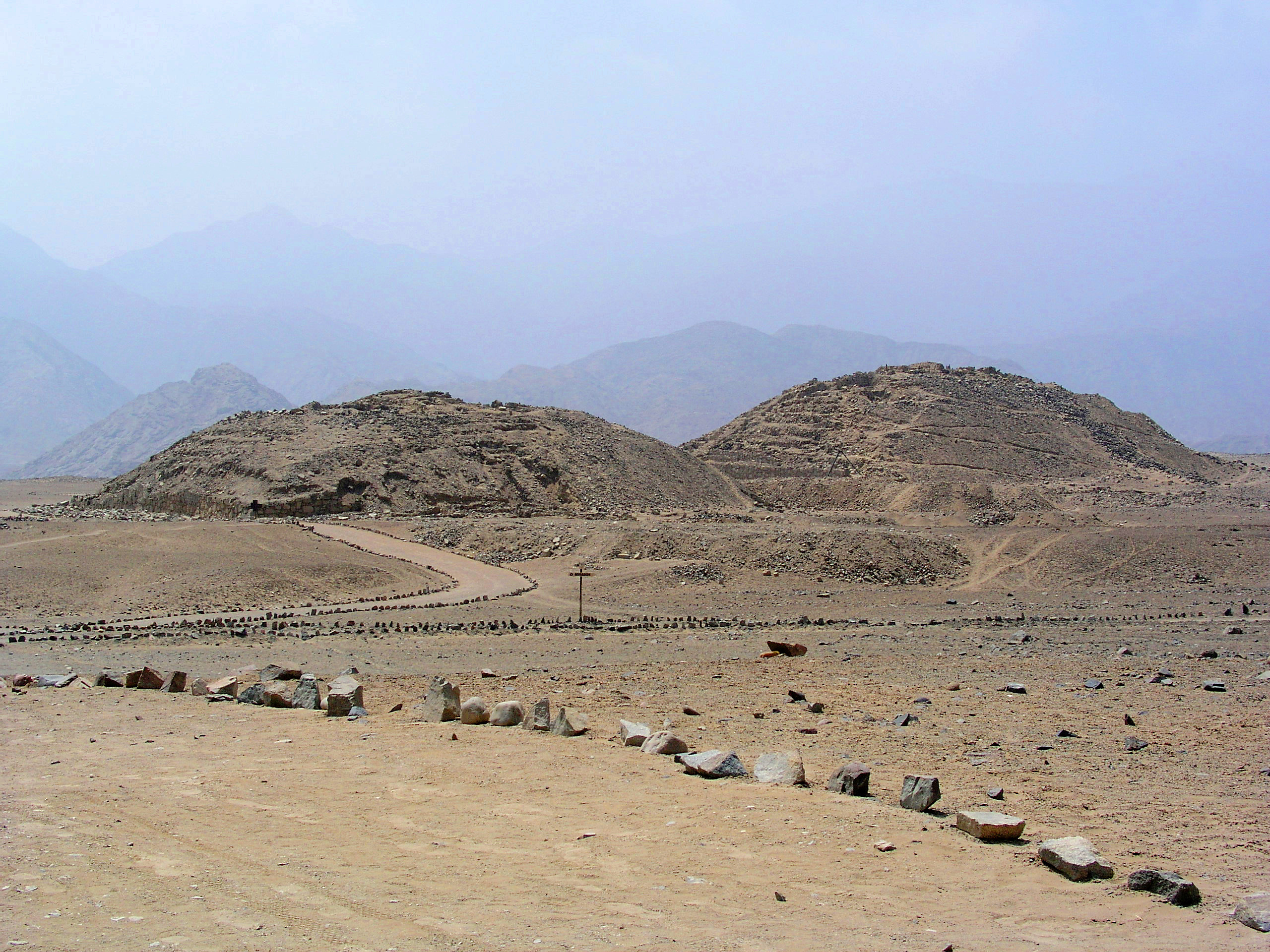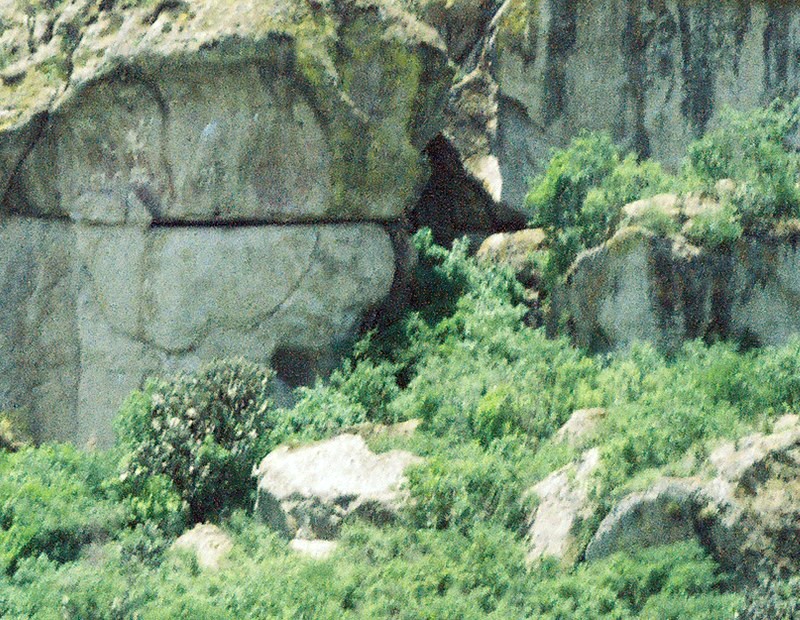|
Huaca Prieta
Huaca Prieta is the site of a prehistoric settlement beside the Pacific Ocean in the Chicama Valley, just north of Trujillo, La Libertad Province, Peru. It is a part of the El Brujo Archaeological Complex, which also includes Moche (culture) sites. Huaca Prieta was occupied as early as 14,500 BP, long before ceramics were introduced. It consists of a huge mound of ash, stones, textiles, plants and shells, with some burials and constructions. Excavations It was first excavated by Junius B. Bird in 1946–1947 who excavated three large test pits in or beside it. The remains, now at the American Museum of Natural History in New York City, include many examples of complex textiles made with twining techniques which incorporated intricate designs of mythological humans, condors, snakes and crabs. The many stone artifacts were not fancy—fish net weights, flakes and simple pebble tools; there were no projectile points. In the upper part of the mound there were many undergro ... [...More Info...] [...Related Items...] OR: [Wikipedia] [Google] [Baidu] |
La Libertad Region
La Libertad (; in English: ''The Liberty'') is a region in northwestern Peru. Formerly it was known as the Department of La Libertad ('). It is bordered by the Lambayeque, Cajamarca and Amazonas regions on the north, the San Martín Region on the east, the Ancash and Huánuco regions on the south and the Pacific Ocean on the west. Its capital is Trujillo, which is the nation's third biggest city. The region's main port is Salaverry, one of Peru's largest ports. The name of the region is Spanish for "freedom" or "liberty"; it was named in honor of the Intendencia of Trujillo's proclaiming independence from Spain in 1820 and fighting for that. It is the ninth smallest department in Peru, but it is also its second most populous department after Piura and its second most densely populated department after Lambayeque. Name During the viceroyalty of Peru, the La Libertad region, together with the present-day regions of Lambayeque, Piura and Tumbes regions in Peru, and Guayaquil ... [...More Info...] [...Related Items...] OR: [Wikipedia] [Google] [Baidu] |
Monte Verde
Monte Verde is an archaeological site in the Llanquihue Province in southern Chile, located near Puerto Montt, Southern Chile, which has been dated to as early as 18,500 cal BP (16,500 BC). Previously, the widely accepted date for early occupation at Monte Verde was about 14,500 years cal BP. This dating added to the evidence showing that the human settlement of the Americas pre-dates the Clovis culture by roughly 1,000 years (or 5,000 years if the 18,500 BP dates are confirmed). This contradicts the previously accepted "Clovis first" model which holds that settlement of the Americas began after 13,500 cal BP. The Monte Verde findings were initially dismissed by most of the scientific community, but the evidence then became more accepted in archaeological circles. Paleoecological evidence of the coastal landscape's ability to sustain human life further supports a " coastal migration" model. Dating of rock surfaces and animal bones suggests the coastal corridor was deglaciated ... [...More Info...] [...Related Items...] OR: [Wikipedia] [Google] [Baidu] |
:Andean Preceramic
The Andean preceramic refers to the early period of human occupation in the Andean area of South America that preceded the introduction of ceramics. This period is also called pre-ceramic or aceramic. Earliest human occupations The earliest humans that came to South America are known as Paleo-Indians. This period is generally known as the Lithic stage. After this came the period that is widely known as Archaic, although there are also some different classifications of this period. The precise classification is complicated because somewhat different terminologies tend to be used for North America and Mesoamerica. The Andean preceramic period would include cultures that belong to Lithic and Archaic stages. Preceramic in Peru The Zaña Valley in northern Peru contains the earliest known canals in South America. These were small stone-lined canals which drew water from streams in the Andes Mountains region. These canals may have been built as early as 4700 BC. A great deal of ... [...More Info...] [...Related Items...] OR: [Wikipedia] [Google] [Baidu] |
:Cotton
Cotton is a soft, fluffy staple fiber that grows in a boll, or protective case, around the seeds of the cotton plants of the genus ''Gossypium'' in the mallow family Malvaceae. The fiber is almost pure cellulose, and can contain minor percentages of waxes, fats, pectins, and water. Under natural conditions, the cotton bolls will increase the dispersal of the seeds. The plant is a shrub native to tropical and subtropical regions around the world, including the Americas, Africa, Egypt and India. The greatest diversity of wild cotton species is found in Mexico, followed by Australia and Africa. Cotton was independently domesticated in the Old and New Worlds. The fiber is most often spun into yarn or thread and used to make a soft, breathable, and durable textile. The use of cotton for fabric is known to date to prehistoric times; fragments of cotton fabric dated to the fifth millennium BC have been found in the Indus Valley civilization, as well as fabric remnants dated back ... [...More Info...] [...Related Items...] OR: [Wikipedia] [Google] [Baidu] |
Cloth Fragment, Cotton And Bast, C
Textile is an umbrella term that includes various fiber-based materials, including fibers, yarns, filaments, threads, different fabric types, etc. At first, the word "textiles" only referred to woven fabrics. However, weaving is not the only manufacturing method, and many other methods were later developed to form textile structures based on their intended use. Knitting and non-woven are other popular types of fabric manufacturing. In the contemporary world, textiles satisfy the material needs for versatile applications, from simple daily clothing to bulletproof jackets, spacesuits, and doctor's gowns. Textiles are divided into two groups: Domestic purposes onsumer textilesand technical textiles. In consumer textiles, aesthetics and comfort are the most important factors, but in technical textiles, functional properties are the priority. Geotextiles, industrial textiles, medical textiles, and many other areas are examples of technical textiles, whereas clothing an ... [...More Info...] [...Related Items...] OR: [Wikipedia] [Google] [Baidu] |
Avocado
The avocado (''Persea americana'') is a medium-sized, evergreen tree in the laurel family (Lauraceae). It is native to Americas, the Americas and was first domesticated by Mesoamerica, Mesoamerican tribes more than 5,000 years ago. Pre-Columbian era, Then as now it was prized for its large and unusually Avocado oil, oily fruit. The tree likely originated in the highlands bridging south-central Mexico and Guatemala. Its fruit, sometimes also referred to as an alligator or avocado pear, is botanically a large Berry (botany), berry containing a single large seed. Avocado trees are partially Self-pollination, self-pollinating, and are often Plant propagation, propagated through grafting to maintain consistent fruit output. Avocados are presently cultivated in the Tropics, tropical and Mediterranean climates of many countries. Agriculture in Mexico, Mexico is the world's List of countries by avocado production, leading producer of avocados as of 2020, supplying nearly 30% of the glo ... [...More Info...] [...Related Items...] OR: [Wikipedia] [Google] [Baidu] |
Tom D
Tom or TOM may refer to: * Tom (given name), a diminutive of Thomas or Tomás or an independent Aramaic given name (and a list of people with the name) Characters * Tom Anderson, a character in '' Beavis and Butt-Head'' * Tom Beck, a character in the 1998 American science-fiction disaster movie '' Deep Impact'' * Tom Buchanan, the main antagonist from the 1925 novel ''The Great Gatsby'' * Tom Cat, a character from the ''Tom and Jerry'' cartoons * Tom Lucitor, a character from the American animated series '' Star vs. the Forces of Evil'' * Tom Natsworthy, from the science fantasy novel ''Mortal Engines'' * Tom Nook, a character in ''Animal Crossing'' video game series * Tom Servo, a robot character from the ''Mystery Science Theater 3000'' television series * Tom Sloane, a non-adult character from the animated sitcom ''Daria'' * Talking Tom, the protagonist from the ''Talking Tom & Friends'' franchise * Tom, a character from the '' Deltora Quest'' books by Emily Rodda * Tom, ... [...More Info...] [...Related Items...] OR: [Wikipedia] [Google] [Baidu] |
National Museum Of Natural History
The National Museum of Natural History is a natural history museum administered by the Smithsonian Institution, located on the National Mall in Washington, D.C., United States. It has free admission and is open 364 days a year. In 2021, with 7.1 million visitors, it was the eighteenth most visited museum in the world and the second most visited natural history museum in the world after the Natural History Museum in London."The World's most popular museums", CNN.com, 22 June 2017. Opened in 1910, the museum on the National Mall was one of the first Smithsonian buildings constructed exclusively to hold the national collections and research facilities. The main building has an overall area of with of exhibition and public space and houses over 1,000 employees. The museum's collections contain over 145 million specimens of plants, animals, fossils, minerals, rocks, meteorites, human remains, and human cultural artifacts, the largest natural history collection in the world. ... [...More Info...] [...Related Items...] OR: [Wikipedia] [Google] [Baidu] |
Dolores Piperno
Dolores Rita Piperno (born 1949) is an American archaeologist specializing in archaeobotany. She is a senior scientist emeritus of the Smithsonian Tropical Research Institute in Balboa, Panama and the Smithsonian National Museum of Natural History, Washington. Early life and education Piperno grew up in Philadelphia before her family moved to Pennsauken, N.J. Piperno earned a B.S. in Medical Technology (Rutgers University, 1971). After graduating, she began her career as a medical technician at the Hematology Research Center of Presbyterian Hospital in Philadelphia. She says she used this training and experience in this field when she moved into archaeology. She then pursued an M.A. in Anthropology ( Temple University, 1979), and a Ph.D. in Anthropology (Temple University, 1983). Research and career Dr. Piperno has worked extensively in the Amazon and Central America. She has also worked in Israel. Her research interests include the study of phytoliths, starch grains, and ... [...More Info...] [...Related Items...] OR: [Wikipedia] [Google] [Baidu] |
Maize
Maize ( ; ''Zea mays'' subsp. ''mays'', from es, maíz after tnq, mahiz), also known as corn ( North American and Australian English), is a cereal grain first domesticated by indigenous peoples in southern Mexico about 10,000 years ago. The leafy stalk of the plant produces pollen inflorescences (or "tassels") and separate ovuliferous inflorescences called ears that when fertilized yield kernels or seeds, which are fruits. The term ''maize'' is preferred in formal, scientific, and international usage as a common name because it refers specifically to this one grain, unlike ''corn'', which has a complex variety of meanings that vary by context and geographic region. Maize has become a staple food in many parts of the world, with the total production of maize surpassing that of wheat or rice. In addition to being consumed directly by humans (often in the form of masa), maize is also used for corn ethanol, animal feed and other maize products, such as corn starch a ... [...More Info...] [...Related Items...] OR: [Wikipedia] [Google] [Baidu] |
Paisley Cave
The Paisley Caves or the Paisley Five Mile Point Caves complex is a system of eight caves in an arid, desolate region of south-central Oregon, United States north of the present-day city of Paisley, Oregon. The caves are located in the Summer Lake basin at elevation and face west, carved into a ridge of Miocene and Pliocene era basalts mixed with soft volcanic tuffs and breccias by Pleistocene-era waves from Summer Lake. One of the caves may contain archaeological evidence of the oldest definitively-dated human presence in North America. The site was first studied by Luther Cressman in the 1930s. Scientific excavations and analysis in the Paisley Caves since 2002 have uncovered substantial new discoveries, including subfossil human coprolites with the oldest DNA evidence of human habitation in North America, various artifacts, and animal remains. The DNA was radiocarbon dated to 14,300 BP or roughly 12,000 BCE. The caves were added to the National Register of Histor ... [...More Info...] [...Related Items...] OR: [Wikipedia] [Google] [Baidu] |
Cactus Hill
Cactus Hill is an archaeological site in southeastern Virginia, United States, located on sand dunes above the Nottoway River about 45 miles south of Richmond. The site receives its name from the prickly pear cacti that can be found growing abundantly on-site in the sandy soil. Cactus Hill may be one of the oldest archaeological sites in the Americas. If proven to have been inhabited 16,000 to 20,000 years ago, it would provide supporting evidence for pre-Clovis occupation of the Americas. The site has yielded multiple levels of prehistoric inhabitance with two discrete levels of early Paleoindian activity. Significance According to some archaeologists, including Dennis Stanford and Joseph and Lynn McAvoy, the Cactus Hill site furnishes evidence of a pre- Clovis population in North America. They consider Cactus Hill significant because it challenges established models of Paleoindian migration. The Clovis first hypothesis which most anthropologists now reject, is the argument t ... [...More Info...] [...Related Items...] OR: [Wikipedia] [Google] [Baidu] |






